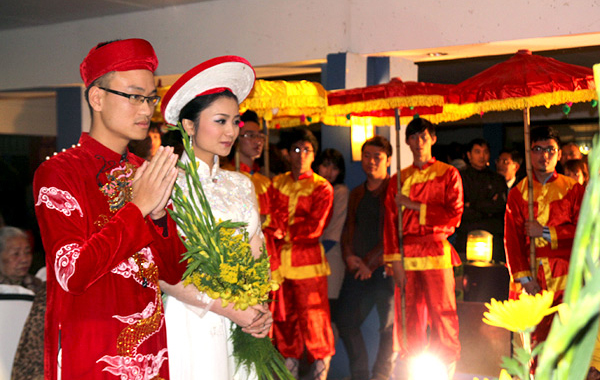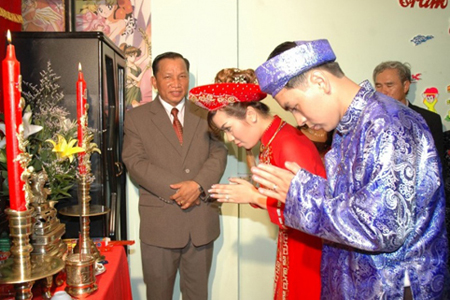Traditionally, weddings take place at the home of the bride’s family. The groom's family comes in a procession bringing offerings for the bride's family's ancestral altar (bàn thờ nhà gái). Some of the offerings should be delivered in advance for distribution to the bride’s relatives. When the requisite offerings have been made, the couple lights incense sticks on the altar to pay homage to the ancestors (gia tiên). The expenses for this ceremony are covered by the groom’s family, who then escorts the bride hack to their home. When the wedding procession arrives at the house of the groom, the bride steps over a brazier set at the entrance to chase off evil spirits. She bows before the grooms family ancestral altar in front of the grandparents and parents of the groom, who offer her money or jewelry. The wedding guests also present gifts and stay in the grooms house for the “red thread ceremony” (lễ tơ hồng), the last stage of the wedding. According to Chinese legend, the God of Marriage (called ông Tơ Hồng, “Lord of the Red Thread,” or Nguyệt Lão, “the Old Man of the Moon”) is supposed to tie the feet of those who are to become husband and wife and write their names in a register that he holds. An altar to Nguyệt Lão, with offerings of boiled chicken, sticky rice, alcohol, and betel may be set up in the yard of the groom’s house. The bridegroom kneels down, then the bride; they listen to the reading of a text in honor of the God of Marriage, thanking him and asking him to ensure a “union of 100 years” and a “fine old age.” They then bow four times.

After the banquet, the family of the bride returns home while the bride remains with the groom’s family. When the bride and groom are left alone together for the first time in their nuptial chamber (dộng phòng), they should in principle chew 100 quids of betel (giầu trăm) to give thanks to the God of Marriage. The 100 betel quids symbolize a long- lasting union. In reality, most couples would share a single betel quid and a cup of alcohol. This exchange of the nuptial cup is called hợp cẩn (uniting of the cup) or giao duyên (union of destinies). The wife spreads a mat on which she sits and bows in front of her husband, who bows to her twice in response. For the first time, the bride and the bridegroom share the same bed. A piece of doth is put under the bride to give proof of her virginity. On the following day, the couple brings ritual offerings to the family of the bride (lễ nhị hỉ or lễ lại mặt). On the tray of offerings is the head of a pig; if it is recognized that the bride has lost her virginity before marriage, the two ears of the pig are cut off, which brings great shame on her family.



